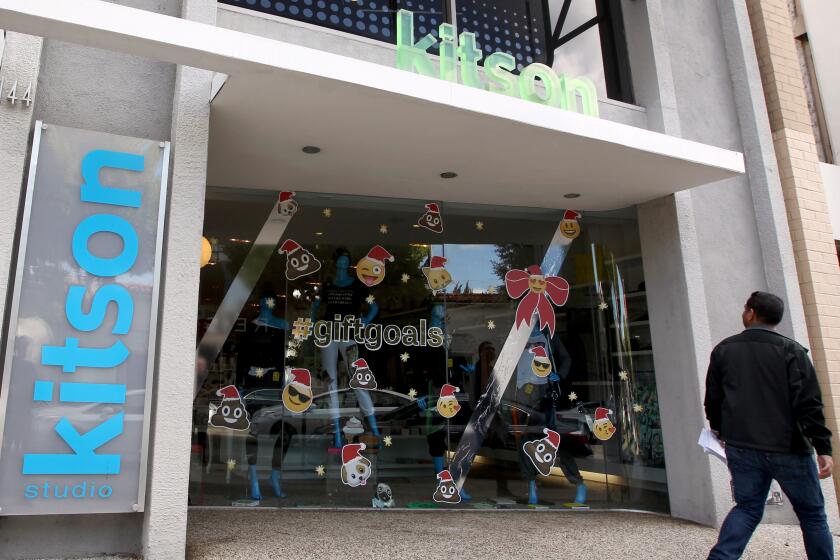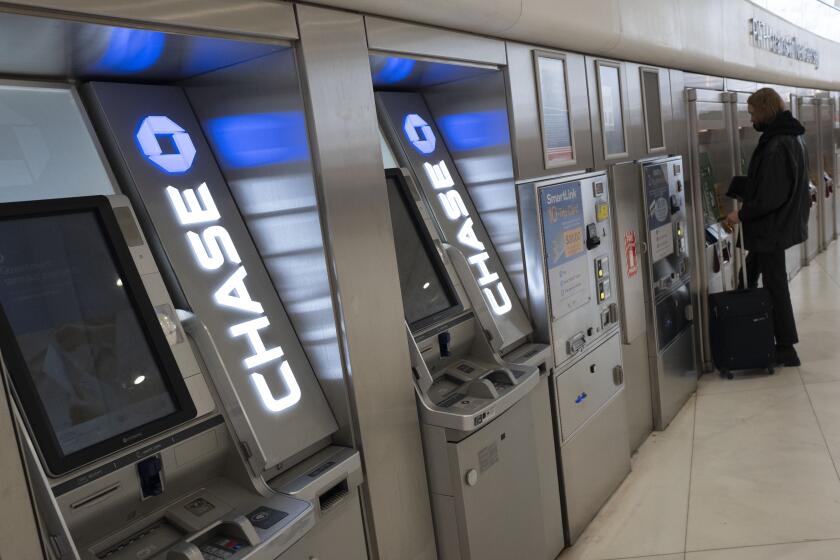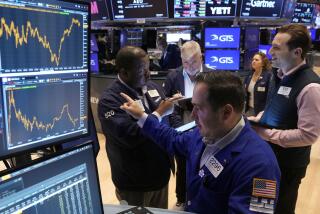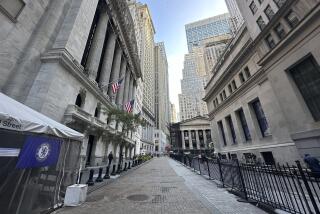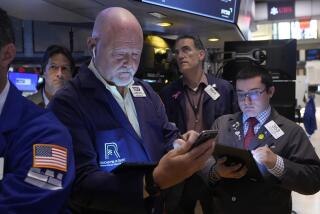Wall Street rallies in relief after Fed’s assurance on rates

- Share via
Wall Street rallied Wednesday after the Federal Reserve’s sharpest hike to interest rates since 1994, and its later assurance that such mega-hikes would not be common.
The Standard & Poor’s 500 index climbed 54.51 points, or 1.5%, to 3,789.99 after whipping through roller-coaster trading immediately after the Fed’s latest move to fight inflation.
In equally topsy-turvy trading, Treasury yields eased in the bond market after Fed Chair Jerome H. Powell seemed to soothe the market’s fears about an overly aggressive central bank by implying more modest rate increases may be coming later this year.
The Dow Jones industrial average swung between a gain of 647 points and a loss of nearly 180 before finishing with a gain of 303.70. It closed at 30,668.53, up 1%. The Nasdaq composite jumped 270.81 points, or 2.5%, to 11,099.15.
The U.S. central bank raised rates amid a widespread sense that inflation is out of control — and, some say, beyond the Fed’s control.
The market’s ebullience was a sharp turnaround from the worldwide rout that has dominated much of this year, which forced the S&P 500 into a bear market earlier this week. The fear has been that high inflation will push the Fed and other central banks to hit the brakes too hard on the economy and create a recession. Wednesday’s gain was the first for the S&P 500 in six sessions.
Some analysts cautioned that the rally could be short-lived, given how deeply and broadly inflation has seeped into the economy and how unsettlingly uncertain the future path is.
“Chair Powell painted as rosy a picture as could be painted, and to achieve that picture that he is laying out, that pathway, a lot has to go right,” said Yung-Yu Ma, chief investment strategist at BMO Wealth Management. “It’s a challenging path, and he acknowledged that.”
The Fed on Wednesday hiked its key short-term interest rate by three-quarters of a percentage point, triple the usual move. Powell said the Fed may consider another increase that big at its next meeting in July, but he also said such a hike is “an unusually large one” and not to expect it to be common.
The Fed is “not trying to induce a recession now, let’s be clear about that,” Powell said. He said Wednesday’s big increase was about the Fed speeding up the move to get interest rates back to normal, calling it “front-end loading.”
“He’s making it extremely clear to the market, to U.S. consumers, that the Fed takes this seriously and is doing whatever it takes to take inflation down and maintain price stability,” said Quincy Krosby, chief equity strategist for LPL Financial.
All kinds of investments, including bonds and bitcoin, have tumbled this year as high inflation forces central banks to swiftly remove supports propped underneath markets early in the pandemic.
Consumers already paying more for gas, groceries and everyday items should expect higher prices in other parts of their lives after the Fed rate increase.
Even if central banks pull off the delicate trick of slowing the economy just enough to stamp out inflation, without a recession, higher interest rates still push down on prices for investments. The hardest-hit have been the investments that soared the most in the easy-money era of ultralow interest rates, including high-growth technology stocks and cryptocurrencies.
Treasury yields this week shot to their highest levels in more than a decade on expectations of a more aggressive Fed, though they eased Wednesday after Powell’s comments. A disappointing report showing that sales at U.S. retailers unexpectedly slumped in May from April contributed.
The economy is still largely holding up amid a red-hot job market, but it has shown some signs of distress recently.
The two-year Treasury yield fell to 3.21% from 3.45% late Tuesday, with the biggest move happening after Powell said 0.75-percentage-point rate hikes wouldn’t be common. The yield on the 10-year Treasury pulled back to 3.28% from 3.48%.
“The bond market right now is driving the broader market and that will continue,” said Jay Hatfield, chief executive of Infrastructure Capital Advisors.
Cryptocurrency prices continued to sink, and bitcoin dropped as low as $20,087.90, nearly 71% below its record of $68,990.90 set late last year. It was down nearly 1% at $21,770 in afternoon trading, according to CoinDesk.
Powell said Wednesday that the Fed is moving “expeditiously” to get rates closer to normal levels after last week’s stunning report that showed inflation at the consumer level unexpectedly accelerated last month. It dashed hopes on Wall Street that inflation may have already peaked.
More bad news came with a report on consumer sentiment showing households’ expectations for future inflation were rising, which could spark a vicious cycle that worsens it.
The war in Ukraine has helped send prices for oil soaring. COVID infections in China, meanwhile, have led to the closure of factories and disrupted supply chains. It all helped pull the S&P 500 down more than 20% from its record set in early January, putting Wall Street into what investors call a bear market.
Many of those concerns are still around, which probably will keep markets volatile.
“Nothing has gone away, nothing looks like it is meaningfully closer to the endgame,” said Ma of BMO Wealth Management. “It still seems like everything is at best highly uncertain.”
Stocks nevertheless also rose in Europe and parts of Asia on Wednesday.
Germany’s DAX returned 1.4% after the European Central Bank called an unscheduled meeting to address worries that rising interest rates will cause turmoil in the continent’s bond market. The central bank did not give a detailed plan, but it said it would act if needed against “fragmentation” as yields for some European countries’ bonds rise much more than for others.
Stocks in Shanghai gained 0.5% after government data showed Chinese factory activity rebounded in May as antivirus controls that shut down businesses in Shanghai and other industrial centers eased.
— Associated Press writers Damian J. Troise and Joe McDonald contributed to this report.
More to Read
Inside the business of entertainment
The Wide Shot brings you news, analysis and insights on everything from streaming wars to production — and what it all means for the future.
You may occasionally receive promotional content from the Los Angeles Times.
